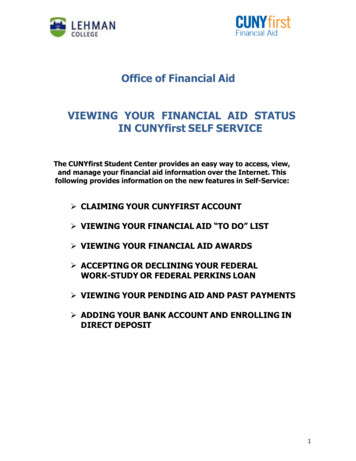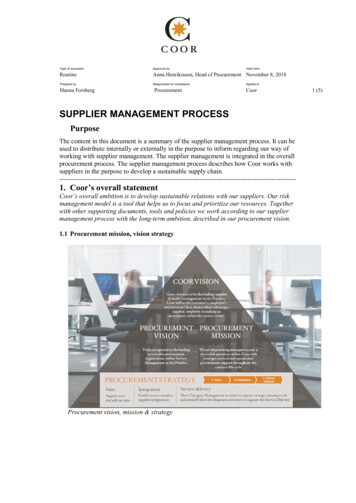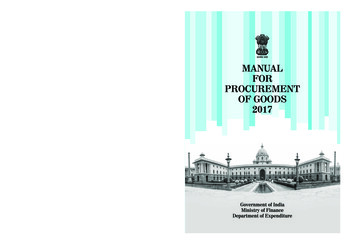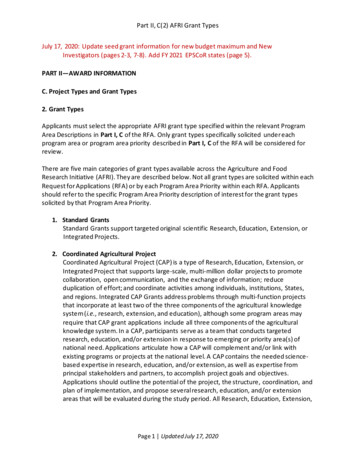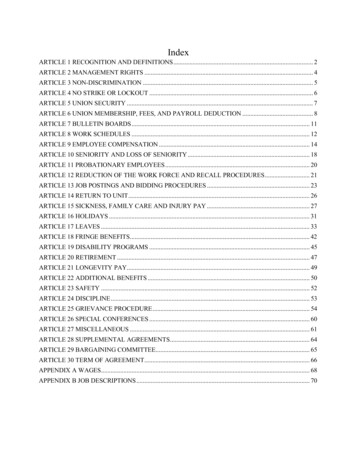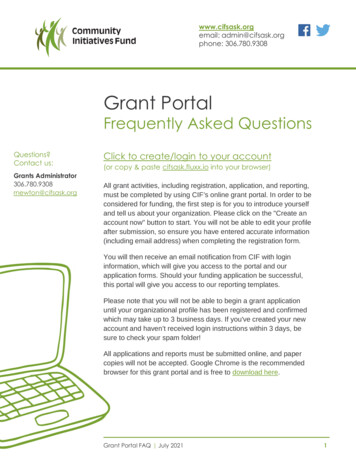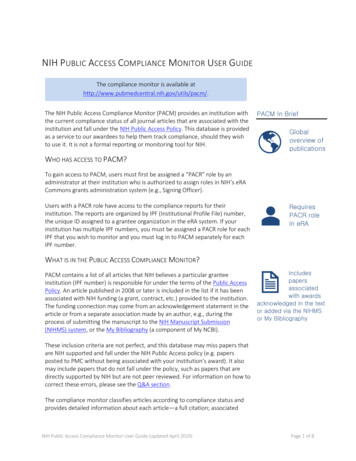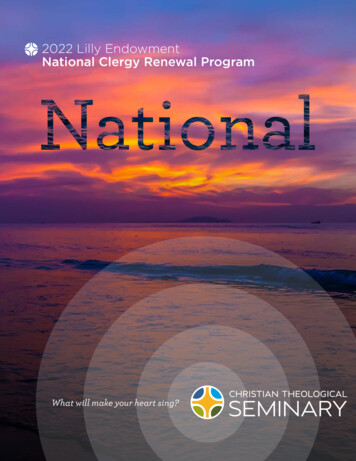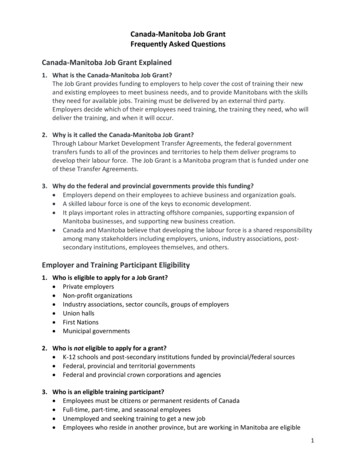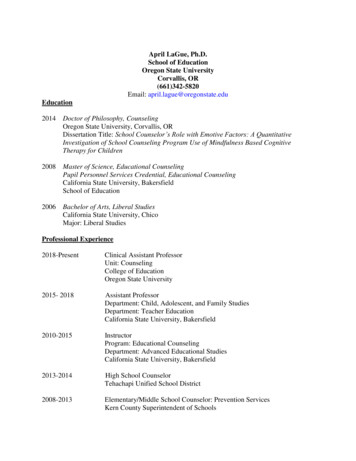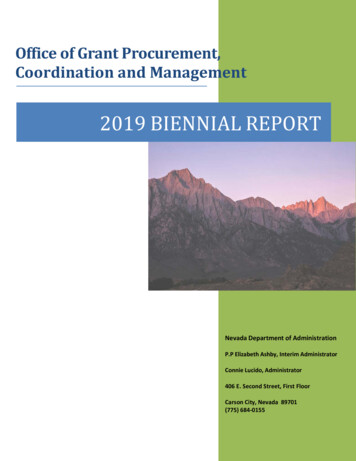
Transcription
Office of Grant Procurement,Coordination and Management2019 BIENNIAL REPORTNevada Department of AdministrationP.P Elizabeth Ashby, Interim AdministratorConnie Lucido, Administrator406 E. Second Street, First FloorCarson City, Nevada 89701(775) 684-0155
2019 BIENNIAL REPORT2019Table of ContentsLetter from the Administrator . 3Office of Grant Procurement, Coordination and Management . 4About the Office of Grant Procurement, Coordination and Management (GO) . 4Mission . 4Background . 4Grant Services Tracker Data. 4Projects . 5Requestor Feedback Data . 5Requestor Engagement Data . 5Key Objectives for GO . 5Accomplishments . 6Increased Capacity . 6Partner Development . 6Policy and Best Practices. 7Professional Development . 7Support of Nevada Advisory Council on Federal Assistance (NACFA) . 8Strategic Grant Services . 9Grant Assistance . 9Grant Management System . 10Funding Trends and Analysis. 10Improved Visibility . 11Public Grant Information . 11Resourceful Website . 11Social Media Presence . 11Surveys and Reporting . 11Future Projects . 13Grant Coordination and Partner Development . 13Catalogue of Federal Domestic Assistance Project. 13Budget Enhancements . 13Silver State Grant Conference. 13Centralized Single Audit Review . 14Formula Grant Funding . 14Update Master Service Agreements . 14APPENDIX A. 1Service Request Summary . 1Service Requests . 2Page 1
2019 BIENNIAL REPORT2019Service Requests by Project . 2Service Requests by Staff . Error! Bookmark not defined.Service Requests by Request Type. 2Number of Service Requests by Organization . 2Number of Service Requests by Type of Requestor . 2Grant Assistance by Assistance Type . 3Rockefeller Institute of Government . 4FiguresFigure 1 – Partner Development by Geography . 6Figure 2 - Rockefeller Institute of Government Nevada Balance of Payments . 4TablesTable 1 - Grants by Grant Type, with Listserv Distribution and Award Ceiling Amount. 10Table 2 - Award Grants Reported in 2018 by Region Impacted . 10Page 2
2019 BIENNIAL REPORT2019Letter from the AdministratorFebruary 1, 2019In accordance with Nevada Revised Statute (NRS) 232.224, theOffice of Grant Procurement, Coordination, and Management(Nevada Grants Office), within the Department of Administration,respectfully submits its Biennial Report to Governor Steve Sisolakand the Nevada State Legislature. During the past two years, theGrants Office continued to generate revenue, develop resources,training, and expertise to ensure Nevada is utilizing pre- and postaward grant best practices.Through collaborative effort with public, private, and non-profitstakeholders across the State, the Nevada GO developedpartnerships and shared resources to increase coordination andimprove successes of competitive grant applications in Nevada.Through strong leadership, direction, and support from ourDepartment Director, the Office of Governor, the NevadaLegislature, public and private stakeholders, and the AdvisoryCouncil on Federal Assistance, Nevada will continue to elevate itsstanding in the grant field.Connie Lucido left the Grant Office shortly before the compilation ofthis report. The information presented took place during heradministration. This report is respectfully submitted on her behalfby Elizabeth Ashby, Interim Administrator.Connie Lucido, AdministratorOffice of Grant Procurement, Coordination and ManagementDepartment of AdministrationPage 3
2019 BIENNIAL REPORT2019Office of Grant Procurement, Coordination and ManagementThis report summarizes the accomplishments of and the grant services provided by the GO usingdata to quantifying activities. Calendar year 2017 was busy as staff prepared to implementchanges. Activities in 2018 included developing the data tracker and its guide, creating the Nevada Grant Policyand the Nevada Grant Manuals, as well as updating the State Administrative Manual, engaging stakeholders,updating the website, coordinating the Grant Management System contract and litigation, and revisingIntergovernmental Review compliance procedures.About the Office of Grant Procurement, Coordination and Management (Grant Office)The Grant Office (GO) is given the authority to operate under NRS 232.222-226 and is charged with helping stateagencies identify federal grant opportunities, develop applications, and the proper management of awardedfunds. Because state agencies have consistently identified the same barriers to maximizing federal grant fundingin Nevada through the biannual Grant Capacity Survey and other GO surveys, the GO’s scope has expandedsignificantly to reduce these barriers. GO activities are collectively referred to as grant services.MissionTo achieve a streamlined, efficient, and sustainable grant process by encouraging agencies to seek funding andsuccessfully manage grants through increased collaboration.BackgroundHistorically, the GO has done an excellent job reporting on the grant services provided by using qualifying data;these reports explained the services provided by giving examples of successful grant proposals that haveresulted in funding. While qualifying data will continue to be important to add color and context to reports, thereports should also include quantifying data related to the grant services provided. As a result, the goals andobjectives stated in the 2017 Biennial Report were modified to align with the capture of quantifying data andthe expanded scope. To accurately explain the impact of the GO through quantifying data, the GO modified itsobjectives and implemented three groups of key data collection. The groups include Grant Service Tracker Data,Requestor Feedback Data, and Requestor Engagement Data. The intent of the three groups of data describedbelow is to give an understanding of the information gathered, analyzed, and presented in this Biennial Report.Grant Services Tracker DataThe Grant Services Tracker was launched in December 2017. It is a tool for GO staff to track all grant relatedactivities daily. It captures all grant services data and replaced individual trackers to increase compliance andreduce unnecessary and inefficient administration of services. The Grant Services Guide provides details of thedata collected as well as the procedures for collection. To summarize, Service Requests (SRs) are categorizedinto reactive and proactive. A requestor is an individual, a public, tribal, or private organization. The organizationof requestors is divided into grant professionals, grant advocate, grant seeker, and grant giver. The six types ofassistance provided by the GO are: funding opportunities, grant assistance, grant resources, partnership andnetworking, training, and technical assistance. Each documented grant service will have both a request type andan assistance type.Please see Appendix A to see a summary of 2018 services requests rendered by the GO.Page 4
20192019 BIENNIAL REPORTProjectsService requests may also be associated with a project in which the GO is currently involved and tracks. Projectshave related activities that may quickly scale.1. Enterprise resource program (ERP)2. Grant management system (GMS)3. State grant workgroup (SGW)4. Nevada Advisory Council on Federal Assistance (NACFA)5. State grant conference (SGC)Requestor Feedback DataThe GO also collects the following data directly from requestors in the form of a feedback survey about grantservices received. This data is critical because it represents the voice of the requestor and quantifies the qualityof the services the GO provides. It also helps to identify potential gaps in the services provided and gives the GOguidance on how to improve or change.1. Service request satisfaction survey2. Event survey3. Online feedback formRequestor Engagement DataRequestors can self-service much information via the GO website, and to some extent, social media.Engagement data from these channels provides a more complete picture of the grant services provided by theGO.Key Objectives for GOThe collection of this data resulted in a redistribution of GO’s resources and redefined goals and objectives. TheGO’s three new objectives and their activities are listed below. GO staff determined these are fundamental tothe GO mission and to reduce barriers to increased grant funding in Nevada.Increase Capacity for GrantManagement Through:a.b.c.d.Partner developmentPolicy and best practicesProfessional developmentSupport of the NevadaAdvisory Council on FederalAssistanceProvide Strategic Grant Services togrant professionals by delivering:a.b.c.Grant assistanceGrant management systemFunding trends and analysisImprove Visibility of the Office via:a.b.c.d.Public grant informationResourceful websiteSocial media presenceSurveys and reportingPage 5
20192019 BIENNIAL REPORTAccomplishmentsIncreased CapacityPartner DevelopmentState Grant WorkgroupThe GO engaged the State Grant Workgroup (SGW) to contribute to determining the needsfor the GMS, contributions to the Nevada Grant Policy and Grant Manuals throughout their developmentprocess. This group was successful in developing partnerships among state agencies with similar programs.Requestor & PartnersA total of 1,459 requestors were served by GO staff in 2018. Of these requestors: 32 states were represented 78.7% were confirmed as being from Nevada (note: this statistic may be higher as state-levelinformation is not captured for all requestors) State agencies represent the greatest percentage of requestors (32.6%), followed by local agencies(24.1%), and nonprofits (20.4%) Most requestors are grant seekers (49.4%) and grant professionals (28.6%) 65.6% should be developed as grant partners and represent 32 Nevada cities and towns with CarsonCity (26.9%), Las Vegas (23.3%), and Reno (20.5%) having the most requestorso Note: 11.2% of requestors to be developed as grant partners do not have city information dueto data completion issuesFigure 1 – Partner Development by GeographyPage 6
2019 BIENNIAL REPORT2019Policy and Best PracticesNevada Grant ManualThe intent of this manual is to provide guidance about grant processes and to direct readers to reliable,authoritative grant-related resources. The GO understands this manual is not all inclusive and expects itto serve as general assistance for administering grants within the state of Nevada. The Nevada GrantManual is posted on the GO website.Nevada Grant Policy ManualThis manual is a series of 21 grant related policies for state agencies administering grants. The policies inthis manual represent best practices statewide. These best practices were gathered in consultation withstate, local, and nonprofit agencies statewide, and in communication with counterparts from otherstates. The policies in this manual serve several purposes: to create efficiencies, reduce audit findings,decrease risk as a recipient of federal funds, enhance competitiveness with other states, andstandardize procedures for federal- and state-funded programs. This is a living document and futurerevisions are expected. See the Nevada Grant Policy Manual on the GO website.State Administrative Manual UpdateThe GO updated the State Administrative Manual (SAM) Chapter 3000 to ensure consistency inreporting by Nevada state agencies by identifying implementation, monitoring, and evaluationrequirements. In addition, the manual includes detailed procedural requirements for theIntergovernmental Review, the requirement of a Master Service Agreement (MSA) for grant contractors,and highlights of laws and regulations related to federal grant procedures. This update also benefitedstate agencies by incorporating the Nevada Grant Policy Manual into the revised language.Professional DevelopmentSilver State Grant ConferenceSince the inception of the Nevada GO in 2011, grant training has been continuously reported as a barrierto securing more federal grant funding in Nevada. Nevada has limited high-quality, low-cost granttraining resources (particularly in rural areas), and the GO continuously fills its free one-day granttraining workshops when they are offered throughout Nevada. In 2016, the GO surveyed grantprofessionals throughout the state and 93.4% of the survey’s 272 respondents indicated they would beinterested in attending a one-day annual statewide grant conference. Leadership is required to drivesuch a capacity-building initiative. In 2018, the Nevada GO provided leadership, as well as operationaland administrative support, totaling more than 1,500 staff hours.By supporting the annual statewide grant conference, the Nevada GO acknowledges the followingbenefits:1.2.3.4.Increase capacity by providing grant training, which may result in more competitiveapplications and an increase in federal grant funding.Increase compliance by providing grant training, which reduces the risk of Nevada losingfederal grant funding.Reduce barriers by increasing collaboration among grant-seeking organizations throughoutNevada, which may result in more competitive applications and an increase in federal grantfunding.Increase visibility of the Nevada GO as a grant authority and resource.Organized by the GO and the Northern Nevada Grant Workgroup, the first-year conference in January2019 offered grant professionals the opportunity to hear thought-provoking discussions from nationallyPage 7
2019 BIENNIAL REPORT2019renowned experts, learn techniques to improve grant writing skills, build networks with grant writingprofessionals across the state and earn continuing professional education. Conference registration wasinitially capped at 200 but due to immense interest, registration was expanded to 300. Conferenceattendees represent 21 different cities and towns in Nevada and three cities in California. The top threeemployment sectors represented were state (27.2%), nonprofit (26.8%), and local/county (26.5%).Special guest U.S. Senator Catherine Cortez Masto welcomed participants during the conference’sopening session. After which, more than 50 seasoned grant professionals shared their knowledgethrough 35 different workshops on topics such as developing effective logic models for continuousprogram improvement and how to prevent common single audit findings. Attendees also heard directlyfrom several federal and state agencies regarding 2019 grant opportunities at the pre-conferencefederal forecast. In 2020, the conference will be held in Las Vegas and rotate annually between northernand southern Nevada, making the GO’s role as organizer critical to conference continuation.Grant WorkshopsOver the biennium, GO staff provided 13 one-day grant workshops throughout the state to train a totalof 233 people with 11 of these 13 trainings held during 2018. Some trainings were specifically for stateagencies, some were open to community organizations, and some trainings were requested. Seventrainings (55.4% of trainees) took place in Carson City, five in Las Vegas (39.5% of trainees), and one(5.2% of trainees) in Tonopah. The scored portion of the training evaluation consisted of six areas ofevaluations that received a rating of strongly agree (5 points), somewhat agree (4 points), neutral (3points), somewhat disagree (2 points), and strongly disagree (1 point). Participants awarded all thetraining workshops 6,308 of 6,655 possible points for an average of 94.8%.Support of Nevada Advisory Council on Federal Assistance (NACFA)Throughout 2018, the GO conducted a series of surveys on behalf of the Nevada Advisory Council onFederal Assistance to gather data and information on the following grant topics: capacity building,sustainability, and match. These surveys were sent to a total of 5,294 people throughout Nevada with aresponse rate of 12.5% and broke out factors into four categories: organization, local, state, and federal.In addition to informing Council decisions and recommendations, these survey results—specificallystate-related factors—provided important directional guidance for the GO. From the survey results, theGO was able to draw the following conclusions: The state factors that somewhat negatively or greatly negatively impact an organization's abilityto apply for and manage federal grant funding include:1. State fiscal/budget requirements/procedures2. State agency’s grant/subaward reporting requirements/procedures3. State agency’s management of subawards Of the state-level solutions provided to increase the amount of federal grant funding in Nevada,the top choice was to standardize Nevada’s grant management policies and forms. More than two-thirds of the capacity building survey’s respondents think capacity building atthe state level would move the needle for organizations’ capacity to apply for and managefederal grant funding to a considerable degree or a great deal. The organizations and regions that self-reported the most capacity for federal grants are nonprofits in the southern region; nearly one out of five state agencies self-reported below averageor very low capacity. The top two state-level factors that impact an organization’s ability to sustain a program afterthe end of federal grant funding, is the program feedback/technical assistance provided by thestate and the accessibility/responsiveness of that agency. The reported lack of capacity at stateagencies may impact sustainability.Page 8
2019 BIENNIAL REPORT 201981.9% of the sustainability survey’s respondents agree or strongly agree that accountabilityaffects sustainability; Nevada can't sustain grant programs if it is at risk of losing federal grantdollars.Around one-quarter of match survey respondents very frequently or frequently pass on a grantopportunity because it requires a match.When it comes to producing or providing the match for a grant application, 48.5% ofrespondents think the grant applicant organization should bear the primary responsibility, while41.4% think the state government should bear the responsibility (respondents could select up totwo options).Two out of three match survey respondents indicated that an available pot of match fundswould definitely or probably increase the number of federal grants their organization appliesfor.Strategic Grant ServicesGrant AssistanceThe GO provided SRs related to 625 unique grants in 2018. In 2018, 816 funding opportunities (bothbefore and after grant proposal deadlines) were identified as follows: 608 (74.5%) were grants from 70 unique federal agencies, 184 (22.5%) were foundationopportunities, 11 (1.4%) from private funders, 6 (0.7%) from 5 state agencies, and 17 (2.1%)from other nonprofits, private organizations, and national associations.746 (91.4%) were competitive and 70 (8.6%) were formulary.Represent a total award opportunity of 2.1B and were sent to 207,214 listserv recipients.149 (18.3%) required a match.Despite grant notification requirements outlined in both Nevada Revised Statute, the StateAdministrative, and Nevada Grant Policy Manuals, state agencies do not consistently notify the GO ofgrant awards. It is optional for local agencies and community organizations to notify the GO of a grantaward.According to USASpending.gov, the best resource of federal award data, Nevada received 6.6B in grantawards in FFY 2018, with 5.5B awarded to State of Nevada agencies. Though the calendar year of GOdata doesn’t align with FFY award data, these representative data sets do show the reporting gap. Thus,the funded grants reported to the GO are not representative of federal grant funds received by Nevadain 2018.In 2018, 75 funded grants were reported to the GO: Total 322M36 (48%) are formulary grants and 39 (52.0%) are competitive grants25 (33.3%) require a match29 (38.7%) are existing grants and 46 (61.3%) are new grants57 (76.0%) impact Nevada statewide, 7 in the southern region (9.3%), 6 in the northern region(8.0%), 3 in the Washoe region (3.0%) and (1) rural region (1.33%). These regions correspond tothe four health districts in Nevada, as determined by AB366 in the 2017 Legislative sessionOf the 75 funded grants reported to the GO in 2018, GO staff provided grant assistance with 22 of these(29.3%), totaling 20,177,602 of grant awards (this grant assistance excludes compliance-relatednotifications such as intergovernmental review or notification of intent to submit a grant proposal). ThePage 9
20192019 BIENNIAL REPORTGO has provided grant assistance to an additional 26 submitted grant proposals totaling 62,719,093; atthis time the award status of these grant proposals is unknown due to either a lack of notificationand/or an award announcement date that has yet to pass.Table 1 - Grants by Grant Type, with Listserv Distribution and Award Ceiling AmountTable 2 - Award Grants Reported in 2018 by Region ImpactedStatewideSouthern RegionNorthern RegionWashoe RegionRural RegionGrand Total5876317577.33%9.33%8.00%4.00%1.33%100.00% 289,375,007 2,750,089 28,288,828 1,688,669 13,856 322,116,449Grant Management SystemThe Legislature approved the GO’s budget requesting funding for a Grant Management System (GMS)last biennium. GO followed the process with support of the Purchasing Division in preparing forrequesting proposals from vendors, and once a vendor was chosen, a letter of intent to award was alsoprepared. The deliverable was the implementation of a statewide Grant Management System.Unfortunately, the appeal of the process of selecting a vendor initiated a prolonged administrativehearing. The administrative hearing process began in Spring of 2017, and the final ruling came in earlyfall of 2018 in favor of the appellant. The Purchasing Division took the matter to District Court where itcurrently resides. The funding for the GMS was requested in the 2019-2021 biennial budget for the GO.Funding Trends and AnalysisThe intent of this activity is for the GO to seek and share information about federal funding trends withpartners to build awareness. The information is researched or received by the GO staff from sourcessuch as the Guinn Center and the Federal Funds Information for States. One report that is worthy ofmention is the Rockefeller Institute on Government report published January 8, 2019 called “Giving orGetting?” This examines where federal funds are generated and spent, the balance of paymentsdifferential that exists between states, the primary explanations for those difference, and how thesegaps may change over time. In this report, Nevada ranks 32nd in the differential in the balance ofPage 10
2019 BIENNIAL REPORT2019payments. Figure 2 in Appendix A provides visual information about this ranking through an excerpt ofthe report.Improved VisibilityPublic Grant InformationThe intent of this activity was to collect information from state agencies and their subrecipients throughThe Grant Management System with the intent to analyze Nevada specific information. Due to thelitigation involved with the Grant Management System, the data collection of this data was not possible.Resourceful WebsiteThe GO staff updated and revised the entire content of its website, www.grant.nv.gov, during thereporting period. The GO provides up to date resources to support the needs of grant seekers and grantprograms statewide. Data research resources are varied, topics range from children to weather. Anindex of the latest state and local needs assessments reports are posted in an easy downloadableformat. The Grant Resources topic, under Reports and Publications provide easy access to the NevadaGrant Policy and the Nevada Grant Manuals, the Biennial Report, and the GO training schedule.Requestors now have access to clear instructions and forms for the Intergovernmental Review processrequired by many federal programs. The result is increased compliance with this federal mandate asmore state, local, nonprofits, and even out-of-state organizations provide notification about possiblegrant submission. The Silver State Grant Conference prompted the development of new webpages toallow attendees, presenters, vendors, and sponsors access to current information about the event.The webpage for the Nevada Advisory Council on Federal Assistance (NACFA) now includes easy way forthe interested parties to request being added to the listserv and an address to send correspondenceabout NACFA. Minutes, agendas, and the schedule of meetings are also easily viewed.Social Media PresenceGO developed the required risk assessment and social media policies before launching its Facebook andTwitter accounts.Surveys and ReportingGO began producing reports with the Tracker data monthly to gauge the information while checking forbugs. As of May 2018, reports are completed quarterly. This report uses the data collected for a fully
of requestors is divided into grant professionals, grant advocate, grant seeker, and grant giver. The six types of assistance provided by the GO are: funding opportunities, grant assistance, grant resources, partnership and networking, training, and technical assistance. Each documented grant service will have both a request type and
